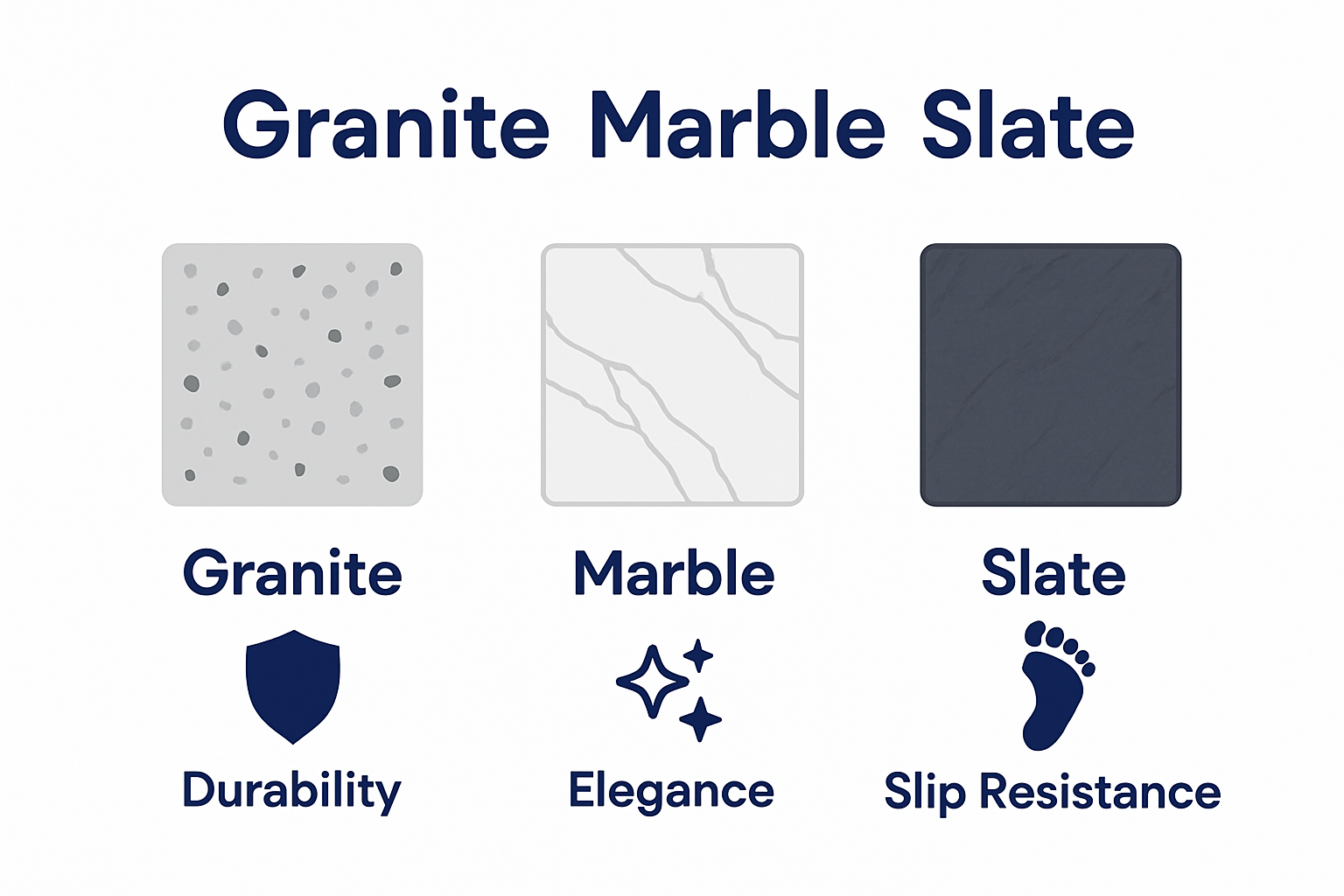What is Natural Stone Tile: A Complete Understanding
Posted by Mike Belk on Aug 28, 2025

Natural stone tile stands out as the original building block of luxury design and timeless style. You might expect that only palaces and cathedrals showcase such elegance but the number of spaces using natural stone tile is skyrocketing with the U.S. Bureau of Labor Statistics projecting a 10% growth in tile and stone applications. Turns out this ancient material is making the biggest impact not just for its looks but because every tile captures a one of a kind slice of earth’s story.
Table of Contents
- Defining Natural Stone Tile And Its Characteristics
- The Importance Of Natural Stone Tile In Design And Architecture
- How Natural Stone Tile Is Sourced And Processed
- Types Of Natural Stone Tiles And Their Unique Properties
- Applications And Trends In The Use Of Natural Stone Tile
Quick Summary
| Takeaway | Explanation |
|---|---|
| Natural stone tiles are premium materials. | Crafted from quarried stones, they exemplify beauty and durability in flooring and wall coverings. |
| Each stone type has unique properties. | Granite, marble, slate, limestone, and sandstone differ in durability, texture, and aesthetic appeal, ideal for varying designs. |
| Sustainability is essential in sourcing. | Modern extraction practices focus on minimizing environmental impact while ensuring high-quality stone materials for construction. |
| Natural stones enhance property value. | Their durability and aesthetic features not only beautify spaces but also significantly increase property valuations over time. |
| Versatile applications abound in design. | From residential bathrooms to commercial lobbies, natural stones are incorporated in innovative ways to elevate spaces. |
Defining Natural Stone Tile and Its Characteristics
Natural stone tile represents a premium flooring and wall covering solution crafted directly from quarried stone materials. These tiles capture the raw beauty and inherent characteristics of earth’s geological formations, transforming them into elegant architectural elements. According to the National Park Service, natural stone tiles are created from solid rock materials extracted from quarries and processed into versatile design components.
Origin and Composition
Natural stone tiles originate from various geological sources, each contributing unique visual and structural properties. The primary stone types used in tile production include:
- Granite: A dense, igneous rock known for exceptional hardness and durability
- Marble: A metamorphic stone characterized by elegant veining and luxurious appearance
- Slate: A fine-grained metamorphic rock offering remarkable texture and slip resistance
- Limestone: A sedimentary rock with soft, neutral tones and moderate durability
- Sandstone: A sedimentary rock featuring natural grain patterns and earthy color variations
Distinctive Characteristics
What distinguishes natural stone tile from manufactured alternatives is its inherent variability and organic aesthetic. Each tile represents a unique piece of geological history, featuring nuanced color gradations, intricate mineral patterns, and individual textural elements. The U.S. Geological Survey emphasizes that these tiles retain the fundamental mineral composition and visual essence of their parent rock.
To help readers distinguish between the primary types of natural stone tiles, the following table organizes their origins, key properties, and ideal applications.
| Stone Type | Geological Origin | Key Properties | Ideal Applications |
|---|---|---|---|
| Granite | Igneous | Exceptional hardness, low porosity, highly durable | High-traffic floors, kitchens |
| Marble | Metamorphic | Elegant veining, luminous, softer than granite | Bathrooms, feature walls |
| Slate | Metamorphic | Textured, slip-resistant, rustic appearance | Bathrooms, outdoor patios |
| Limestone | Sedimentary | Soft neutral tones, moderate durability | Living rooms, wall cladding |
| Sandstone | Sedimentary | Grain patterns, earthy colors, gentle texture | Outdoor areas, patios |
Physical Properties:
- Exceptional durability and longevity
- Natural thermal conductivity
- Varied porosity levels depending on stone type
- Resistance to wear and environmental stress
Beyond aesthetic appeal, natural stone tiles offer remarkable versatility for residential and commercial spaces. Discover more about integrating natural stone into contemporary design.
The Importance of Natural Stone Tile in Design and Architecture
Natural stone tile transcends mere functional flooring, emerging as a pivotal element in architectural expression and design sophistication. According to the National Park Service, stone materials have been fundamental in preserving cultural architectural heritage, representing both aesthetic elegance and structural integrity.
Aesthetic Versatility and Design Impact
Natural stone tiles offer unparalleled design flexibility, enabling architects and designers to create spaces that communicate distinct visual narratives. Their inherent variations in color, texture, and pattern allow for unique design compositions that transform ordinary environments into extraordinary spaces. Whether employed in minimalist contemporary settings or traditional architectural contexts, natural stone tiles provide a timeless design language that communicates sophistication and refined taste.
Architectural Functionality and Performance
Beyond aesthetic considerations, natural stone tiles deliver remarkable functional advantages that make them integral to modern architectural practices:
- Exceptional Durability: Withstanding heavy foot traffic and environmental stressors
- Thermal Regulation: Natural heat conductivity for improved interior climate control
- Acoustic Properties: Dense material composition reduces sound transmission
- Long-term Value: Increased property valuation through premium material selection
Cultural and Environmental Significance
Natural stone tiles represent more than architectural materials they embody geological narratives and sustainable design principles. Each tile connects contemporary spaces with ancient geological processes, creating a profound link between human design and natural formations. Explore innovative ways to incorporate natural stone in modern interiors, transforming spaces with timeless elegance and environmental consciousness.
How Natural Stone Tile is Sourced and Processed
Natural stone tile production represents a sophisticated journey from geological formation to architectural element, involving complex extraction and transformation processes. According to the Natural Stone Institute, modern stone sourcing emphasizes responsible quarrying practices that balance environmental stewardship with material procurement.
Quarrying and Extraction Methods
The initial stage of natural stone tile production involves precise geological assessment and strategic extraction. Specialized teams utilize advanced techniques to identify and extract stone blocks with minimal environmental disruption. Key extraction methods include:
- Block Cutting: Utilizing diamond wire saws and hydraulic splitters
- Surface Mining: Removing overburden to access high-quality stone deposits
- Underground Quarrying: Extracting stone from deeper geological formations
- Selective Extraction: Targeting specific stone varieties with minimal ecological impact
Processing and Fabrication Techniques
Once extracted, stone blocks undergo meticulous transformation into refined tiles. This process involves multiple precision stages that convert raw geological materials into architecturally sophisticated surfaces. The fabrication sequence includes:
- Cutting large blocks into manageable slabs
- Calibrating thickness for uniform tile dimensions
- Applying surface treatments like polishing, honing, or brushing
- Precise edge finishing to ensure architectural compatibility
Sustainability and Quality Control
Modern stone tile production integrates rigorous quality assessment with sustainable manufacturing principles. Manufacturers increasingly adopt environmentally conscious practices, including water recycling systems and energy-efficient processing techniques. Learn more about sustainable tile selection for your next project, ensuring both aesthetic excellence and environmental responsibility.
Types of Natural Stone Tiles and Their Unique Properties
Natural stone tiles represent a diverse family of geological materials, each offering distinctive characteristics that influence their architectural and design potential. According to the National Park Service, understanding the fundamental properties of different stone types is crucial for selecting the most appropriate material for specific design environments.
Igneous Stone Tiles
Granite emerges as the quintessential igneous stone tile, renowned for its exceptional durability and complex crystalline structure. Characterized by dense mineral composition, granite tiles provide unparalleled strength and resistance to wear.

Key attributes include:
- Extremely hard surface with minimal porosity
- Diverse color palette ranging from deep blacks to speckled grays
- Superior resistance to scratching and impact
- Ideal for high-traffic areas like kitchen floors and commercial spaces
Metamorphic Stone Tiles
Metamorphic stones like marble and slate offer dramatically different aesthetic and functional properties. Marble, with its elegant veining and luminous appearance, represents luxury and sophistication. Slate, conversely, provides a more rustic and textured surface ideal for creating natural, organic design statements.
- Marble: Soft, elegant appearance with intricate color variations
- Slate: Rugged texture with excellent slip resistance
- Varying levels of hardness and maintenance requirements
- Unique visual narratives embedded in each tile
Sedimentary Stone Tiles
Sedimentary stones such as limestone and sandstone introduce earthy, organic design elements with softer visual characteristics. These stones offer more nuanced color palettes and gentler textures, making them perfect for creating warm, inviting spaces. Explore innovative design possibilities with natural stone tile selections, understanding how each stone type contributes to architectural storytelling.
Applications and Trends in the Use of Natural Stone Tile
Natural stone tile continues to evolve as a dynamic design element, transcending traditional architectural boundaries and adapting to contemporary aesthetic and functional demands. According to architecture experts, natural stone represents more than a material choice it symbolizes a design philosophy that connects human spaces with geological narratives.
Residential Design Innovations
Modern residential applications of natural stone tiles demonstrate remarkable versatility, transforming living spaces into sophisticated environments. Homeowners and designers are increasingly exploring creative implementations that go beyond conventional flooring:
- Kitchen backsplashes featuring intricate marble patterns
- Bathroom walls with textured slate installations
- Fireplace surrounds utilizing dramatic granite compositions
- Outdoor patio areas with sandstone tile arrangements
Commercial and Public Space Trends
In commercial environments, natural stone tiles communicate elegance, durability, and institutional gravitas. From corporate lobbies to government buildings, these materials create powerful visual statements while delivering exceptional performance. The U.S. Bureau of Labor Statistics projects a 10% growth in tile and stone applications, reflecting increasing design sophistication and material appreciation.
Emerging Design and Sustainability Trends
Contemporary natural stone tile applications are increasingly characterized by sustainability, technological integration, and design innovation. Designers are exploring:
- Larger format tiles for minimalist aesthetic
- Mixed stone compositions creating visual complexity
- Eco-friendly sourcing and processing techniques
- Digital printing technologies enhancing stone tile design possibilities
Discover the latest mosaic tile trends transforming interior design, understanding how these materials continue to reshape architectural expression.
Elevate Your Space With Timeless Natural Stone Solutions
If you have learned about the unmatched elegance and resilience of natural stone tile but are unsure where to begin your own project, you are not alone. Finding the perfect blend of character, durability, and design flexibility can be overwhelming. As the article explains, each natural stone tile brings its own unique texture and legacy into your home or commercial space, making selection a deeply personal decision. Whether you seek a statement kitchen backsplash, a luxurious bathroom, or a striking entryway, it is important to choose the right material that expresses your vision and meets your performance needs.
Ready to transform your ideas into reality? Explore the outstanding range of natural stone and specialty tiles curated just for you at BELK Tile. Use the easy website filters to find tiles by type, application, color, and style, and let the inspirational galleries guide your design journey. Do not wait to bring your enduring vision to life with tiles that add lasting value and beauty. Visit BELK Tile’s main site now and start creating a space that truly reflects your taste, style, and needs.
Frequently Asked Questions
What is natural stone tile made of?
Natural stone tile is made from quarried geological materials, including granite, marble, slate, limestone, and sandstone. Each type offers unique visual characteristics and physical properties.
What are the benefits of using natural stone tile?
Natural stone tile provides exceptional durability, natural thermal conductivity, aesthetic versatility, and a unique texture. It also adds significant long-term value to both residential and commercial spaces.
How does natural stone tile compare to ceramic or porcelain tile?
Unlike ceramic or porcelain tiles, which are manufactured, natural stone tiles are quarried from the earth. This results in unique colors and patterns for each tile, while ceramic and porcelain tiles offer more uniformity. Natural stone is generally more durable but may require more maintenance than ceramic options.
The following table provides a concise comparison of natural stone tiles, ceramic tiles, and porcelain tiles based on manufacturing, appearance, durability, and maintenance requirements as discussed in the FAQs.
| Tile Type | Manufacturing Process | Appearance | Durability | Maintenance Needs |
|---|---|---|---|---|
| Natural Stone Tile | Quarried from the earth | Unique colors and patterns; each tile is distinct | Generally very durable | Requires periodic sealing |
| Ceramic Tile | Manufactured (clay fired) | Uniform colors and designs; consistent appearance | Durable, variable by type | Low; easy to clean |
| Porcelain Tile | Manufactured, dense clay | Highly uniform; can mimic natural stone | Highly durable, dense | Low; resistant to moisture |
How should natural stone tile be maintained?
Maintaining natural stone tile involves regular cleaning with pH-neutral products, periodic sealing to protect against moisture and staining, and addressing spills promptly. Specialized care may be required depending on the type of stone used.



